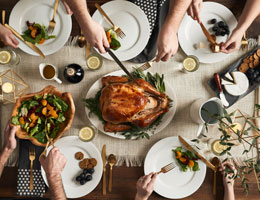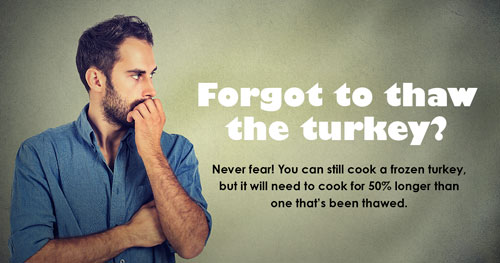
Nov. 25, 2020—It's the day before Thanksgiving, and if turkey is on the menu, you probably have your plan all dialed in.
But if you're scrambling to figure out a last-minute method for cooking that bird, here are three tried-and-true techniques from the U.S. Department of Agriculture (USDA) that will help you make a delicious, safe meal.
1. Traditional roasting
Set your oven to a minimum of 325 degrees. Place your thawed turkey in a shallow roasting pan. The size of the turkey will determine the cooking time, so plan accordingly. An 8- to 12-pound bird will take about 3 hours. A 20- to 24-pound one can take up to 5 hours.
Even if your turkey has a pop-up thermometer, use a food thermometer to be sure it's fully cooked. The internal temperature should be at least 165 degrees in the innermost part of the thigh and of the wing, and in the thickest part of the breast.
What's that? You haven't thawed the turkey yet?
OK. No problem. You can totally cook a frozen turkey. Just know that it takes 50% longer to get completely done than it would have if it had been thawed. If you can't get the giblet package out of the frozen bird, carefully remove it with tongs or a fork after the turkey has defrosted in the oven.

2. Traditional stuffed roasting
Prepare your stuffing shortly before putting your turkey in the oven. Then loosely fill the bird's cavities with the warm stuffing using a spoon. Don't try to cram it, and don't let the stuffing cool.
If you're preparing your stuffing ingredients ahead of time, keep wet items (like butter, cooked vegetables and broth) chilled. And keep them separate from dry items (like spices or bread cubes) until just before it's time to stuff.
Cook your turkey using the traditional roasting method. The internal temperature of the bird should still reach a minimum of 165 degrees—and so should the center of the stuffing. Remove the stuffing before carving.
3. Oven-bag roasting
This method has two advantages over traditional roasting that may be really appealing for a last-minute meal: The turkey will cook faster and the cleanup is easier. Place the turkey in an oven bag specifically designed for cooking. Follow the directions on the oven-bag packaging. Test for doneness with a food thermometer in the same places as traditional roasting.
You can cook a stuffed or unstuffed turkey in an oven bag—add 30 minutes to the cooking time if it's stuffed. But don't cook a frozen turkey in a bag.
More turkey talk
Have a burning question? Call the USDA Meat and Poultry Hotline at 888.MPHotline (888.674.6854). Food safety specialists are there to answer your questions in English and Spanish from 10 a.m. to 6 p.m. Eastern, Monday through Friday—and from 8 a.m. until 2 p.m. Eastern on Thanksgiving. Or email them anytime at mphotline.fsis@usda.gov.